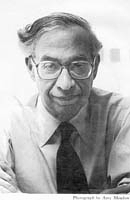
Donald Allen Wollheim was an American science fiction editor, publisher, writer, and fan. As an author, he published under his own name as well as under pseudonyms, including David Grinnell, Martin Pearson, and Darrell G. Raynor. A founding member of the Futurians, he was a leading influence on science fiction development and fandom in the 20th-century United States. Ursula K. Le Guin called Wollheim "the tough, reliable editor of Ace Books, in the Late Pulpalignean Era, 1966 and '67", which is when he published her first two novels in Ace Double editions.
Pulp magazines were inexpensive fiction magazines that were published from 1896 until around 1955. The term "pulp" derives from the cheap wood pulp paper on which the magazines were printed. In contrast, magazines printed on higher-quality paper were called "glossies" or "slicks". The typical pulp magazine had 128 pages; it was 7 inches (18 cm) wide by 10 inches (25 cm) high, and 0.5 inches (1.3 cm) thick, with ragged, untrimmed edges. Pulps were the successors to the penny dreadfuls, dime novels, and short-fiction magazines of the 19th century.

Baen Books is an American publishing house for science fiction and fantasy. In science fiction, it emphasizes space opera, hard science fiction, and military science fiction. The company was established in 1983 by science fiction publisher and editor Jim Baen. After his death in 2006, he was succeeded as publisher by long-time executive editor Toni Weisskopf.

A paperback book is one with a thick paper or paperboard cover, and often held together with glue rather than stitches or staples. In contrast, hardback (hardcover) books are bound with cardboard covered with cloth, leather, paper, or plastic.
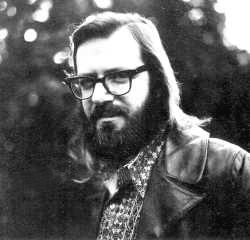
Terry Gene Carr was an American science fiction fan, author, editor, and writing instructor.

Ballantine Books is a major American book publisher that is a subsidiary of German media conglomerate Bertelsmann. Ballantine was founded in 1952 by Ian Ballantine with his wife, Betty Ballantine. Ballantine was acquired by Random House in 1973, which in turn was acquired by Bertelsmann in 1998 and remains part of that company.
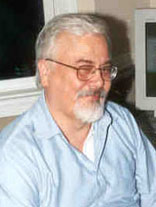
James Patrick Baen was a U.S. science fiction publisher and editor. In 1983, he founded his own publishing house, Baen Books, specializing in the adventure, fantasy, military science fiction, and space opera genres. Baen also founded the video game publisher, Baen Software. In late 1999, he started an electronic publishing business called Webscriptions, which is considered to be the first profitable e-book vendor.
Patricia Nead Elrod is an American novelist specializing in urban fantasy. She has written in the mystery, romance, paranormal, and historical genres with at least one foray into comedic fantasy. Elrod is also an editor, having worked on several collections for Ace Science Fiction, DAW, Benbella Books, and St. Martin's Griffin. She self-published a signed, limited edition novel under her own imprint, Vampwriter Books.

A. A. Wyn was an American publisher.

In bookbinding, a dos-à-dos binding is a binding structure in which two separate books are bound together such that the fore edge of one is adjacent to the spine of the other, with a shared lower board between them serving as the back cover of both. When shelved, the spine of the book to the right faces outward, while the spine of the book to the left faces the back of the shelf; the text of both works runs head-to-tail.
Lancer Books was a publisher of paperback books founded by Irwin Stein and Walter Zacharius that operated from 1961 through 1973. While it published stories of a number of genres, it was noted most for its science fiction and fantasy, particularly its series of Robert E. Howard's Conan the Barbarian tales, the first publication of many in paperback format. It published the controversial novel Candy by Terry Southern and Mason Hoffenberg, and Ted Mark's ribald series The Man from O.R.G.Y. Lancer paperbacks had a distinctive appearance, many bearing mauve or green page edging.
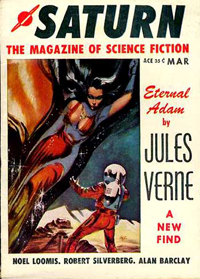
Saturn was an American magazine published from 1957 to 1965. It was launched as a science fiction magazine, but sales were weak, and after five issues the publisher, Robert C. Sproul, switched the magazine to hardboiled detective fiction that emphasized sex and sadism. Sproul retitled the magazine Saturn Web Detective Story Magazine to support the change, and shortened the title to Web Detective Stories the following year. In 1962, the title was changed yet again, this time to Web Terror Stories, and the contents became mostly weird menace tales—a genre in which apparently supernatural powers are revealed to have a logical explanation at the end of the story.
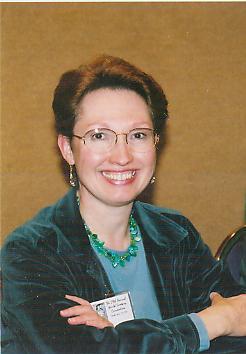
Lillian Stewart Carl is an American author of mystery, fantasy and science-fiction novels.
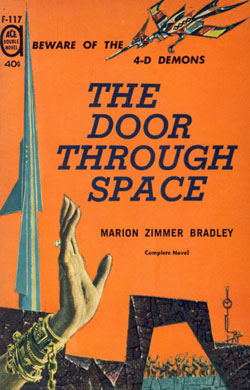
The Door Through Space is a 1961 science fiction novel by American writer Marion Zimmer Bradley. An expansion of Bradley's story "Bird of Prey", which first appeared in the May 1957 issue of the magazine Venture, it is her first novel, and was published by Ace Books, bound tête-bêche with Rendezvous on a Lost World by A. Bertram Chandler.

Avon published three related magazines in the late 1940s and early 1950s, titled Avon Fantasy Reader, Avon Science Fiction Reader, and Avon Science Fiction and Fantasy Reader. These were digest size magazines which reprinted science fiction and fantasy literature by now well-known authors. They were edited by Donald A. Wollheim and published by Avon.

The Annual World's Best SF was a series of annual paperback anthologies published by American company DAW Books from 1972 to 1990 under the editorship of publisher Donald A. Wollheim and Arthur W. Saha from 1972 to 1990. Some volumes were also issued in hardcover through the Science Fiction Book Club. It was a continuation of the earlier anthology series World's Best Science Fiction, edited by Wollheim and Terry Carr, published from 1965 to 1971 by Ace Books DAW also issued the companion series The Year's Best Horror Stories from 1971 to 1994, and The Year's Best Fantasy Stories from 1975 to 1988.
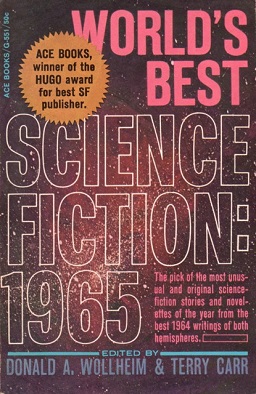
World's Best Science Fiction was a series of annual paperback anthologies published by Ace Books from 1965 to 1971 under the editorship of Donald A. Wollheim and Terry Carr. Some volumes were also issued in hardcover through the Science Fiction Book Club or by Gollancz.

The Best Science Fiction of the Year was a series of annual paperback anthologies edited by Terry Carr. It was published by Ballantine Books from 1972 to 1980, Pocket Books from 1981 to 1983, Baen Books in 1984, and Tor Books from 1985 to 1987. The Tor Books volumes bore the title Terry Carr's Best Science Fiction of the Year from 1985 to 1986, and Terry Carr's Best Science Fiction and Fantasy of the Year in 1987. Most volumes were also issued in hardcover in the United Kingdom by Gollancz, the last three under the variant title Best SF of the Year. The series was a continuation of the earlier anthology series World's Best Science Fiction, edited by Carr with Donald A. Wollheim, published from 1965 to 1971 by Ace Books.

World's Best Science Fiction: 1965 is an anthology of science fiction short stories edited by Donald A. Wollheim and Terry Carr, the first volume in a series of seven. It was first published in paperback by Ace Books in 1965. It was reprinted by the same publisher in 1970 under the alternate title World's Best Science Fiction: First Series.

















